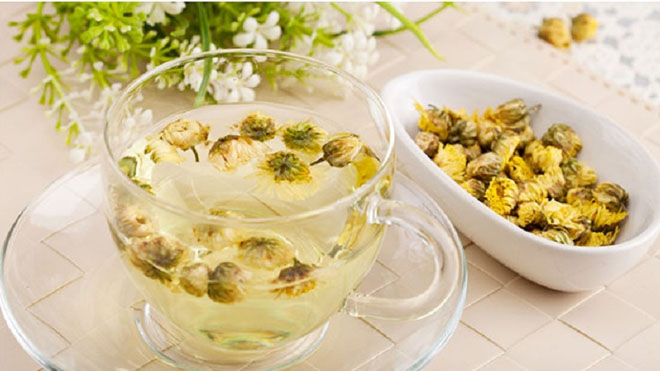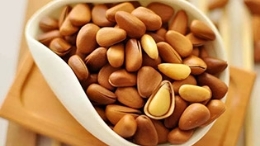Chrysanthemum is used not only in landscape design, but also in cosmetology and medicine. This genus of herbaceous plants of the Astrov family includes many species and varieties that grow mostly in Asia. They vary greatly in size, appearance and coloration.

However, only a few varieties of chrysanthemum are classified as edible. In China, these flowers are widely used to make tea.
What is this tea
Tea chrysanthemums with small flowers are usually pre-dried. During the brewing process, when a dry bud falls into hot water, it swells, increases in size and blossoms.
Chrysanthemum has a refreshing and tonic effect and is suitable for preparation with green tea, and also combined with Puerh. The flowers slightly soften the pronounced taste of the latter, add sweetness, and bring floral and coniferous notes to the aroma.
Varieties for tea
Only a few varieties of this flower are suitable for eating. In the Chinese provinces of Henan, Zhejiang, and Anhui, varieties suitable for this purpose are grown, which include:
1. Hangzhou (Hang Ju). It has fairly large pure white or slightly yellowish flowers. Chrysanthemum tea has a clean, well-distinguished aroma, sweet aftertaste with a slight bitter note. When using buds that have not yet opened, a more pronounced taste and benefit can be achieved, since their composition is richer in polyphenols.
2. Huai Ju. Yellow or completely white flowers grown for many centuries in the country. Healing properties are attributed to tea from this culture: it helps to get rid of problems with the liver and eyesight. Plants of this variety became the basis for the breeding of medicinal species.
3. Chrysanthemum from Bozhou (Bo Ju). A medicinal plant cultivated for more than 2 centuries. A striking feature of the variety is the ease with which the buds part with the petals. Usually, when preparing tea, dried flowers are used and sugar is necessarily added. The infusion is useful for colds or during the heat outside.
4. Hangzhou white chrysanthemum (Han Bai Ju). It belongs to the well-known varieties, it is often called the great plant of Zhejiang province. This name was given to the flower due to its medicinal qualities. It is believed that tea with its buds helps to solve skin problems, pressure surges, and also has an anti-inflammatory effect.
Deserve the attention of connoisseurs Wild chrysanthemum (E Ju Hua) with small dark yellow flowers, Chrysanthemum for the Emperor (Gong Ju) with white buds that have a medicinal effect, Chusskaya (Chu Ju), giving a bitter taste and healing properties to the drink.
You can also use Thai yellow chrysanthemum to brew tea. Its flowers are smaller than those of Chinese varieties, giving a less pronounced aroma. The infusion is clear, yellowish, with a delicate floral taste.
Is there any benefit
According to the ideas of ancient Chinese medicine, chrysanthemum tea can give longevity and health. According to one of the legends, the monk, eating dew from the petals of white chrysanthemums, gained immortality. Among the useful properties of the plant:
- removal of toxins and slags;
- lowering blood pressure;
- strengthening muscle tone;
- increase immunity, protection against colds;
- help in the treatment of inflammatory diseases;
- normalization of sleep patterns;
- maintaining the body under stress, overstrain;
- decrease in body temperature.
How to brew
Tea with the addition of chrysanthemum flowers acquires a green tint, a floral aroma with spicy tones. The taste of the drink remains close to natural, but sweetish notes appear.
You should not add more petals than the brewing method suggests, otherwise the pronounced taste of chrysanthemum will displace the taste of the tea itself.
There are several options for preparing a flower drink.
Method 1. Only from flowers, without adding tea leaves
To get this infusion:
- 1 tsp dry flowers pour 150-200 ml of hot water. The liquid temperature should be 80-85°C.
- Insist 1-3 min.
- Pour into cups.
If brewing is carried out by the pouring method, then it is worth adding 8 g of dried chrysanthemum flowers to the gaiwan. Exposure time 5-15 sec.
Method 2. With black or green tea
This chrysanthemum infusion recipe is similar to making rosebud tea (Mei Gui Hua Bao). Brewing:
- Pour 1 tsp into the bottom of the teapot. dry welding.
- Put 1-2 chrysanthemum buds.
- Pour 200 ml of water at a temperature of 80-85°C for the green variety or 95-100°C for the black variety, cover with a lid.
- Insist 3-5 minutes.
A delicate floral scent and sweetness will be added to the taste and aroma of tea leaves.
Chrysanthemum flowers can also be found in related teas .
Possible harm
With proper brewing and moderate consumption, chrysanthemum tea has a positive effect on the body. However, its uncontrolled use can cause vomiting or indigestion, provoke the appearance of a rash, itching, palpitations, and pain in the abdomen.
It is worth limiting consumption or abandoning the drink for those who suffer from an allergy to flowers, as well as:
- pregnant women and nursing mothers;
- children under 12;
- with diseases of the cardiovascular system;
- suffering from problems with the gastrointestinal tract;
- with a history of spleen or kidney disease.
In eastern countries, chrysanthemum is a frequent ingredient for making tea. When properly brewed, the flowers give the drink a delicate aroma and characteristic taste, while not overlapping the own character of the tea leaves, but complementing and shading it.



